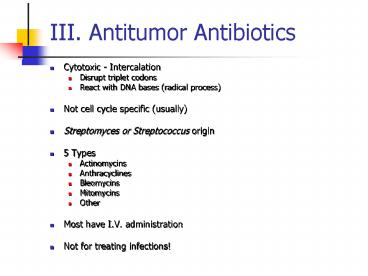III' Antitumor Antibiotics
1 / 12
Title: III' Antitumor Antibiotics
1
III. Antitumor Antibiotics
- Cytotoxic - Intercalation
- Disrupt triplet codons
- React with DNA bases (radical process)
- Not cell cycle specific (usually)
- Streptomyces or Streptococcus origin
- 5 Types
- Actinomycins
- Anthracyclines
- Bleomycins
- Mitomycins
- Other
- Most have I.V. administration
- Not for treating infections!
2
Antineoplastic Agents
What exactly is intracalation by a chemical
agent with DNA?
Nature Structural Biology 9, 57 - 60 (2002) a,
Scheme for the DNAcryptolepine complex. b,
Stereo view of two bis-intercalated d(CCTAGG)2
Four asymmetric units are represented in
different colors. c, Stereo view of the 2Fo - Fc
electron density map into the major groove. d,
Stereo view of the projection down the helix
axis Cryptolepine is a anti-malarial agent
3
Antibiotics Actinomycins
Indications Wilms tumor, rhabdomyosarcoma,
choriocarcinoma, Ewings sarcoma, Peds
sarcoma Extremely corrosive to soft tissuesuse
care to prevent extravasation MOA Intercalates
DNA preventing DNA synthesis, cell cycle
non-specific Natural product, toxic effects occur
2-4 days following therapy, anemia, drug
concentrates in nucleated cells and not
detectable after 2 minutes---half-life 36
hours Potentiates radiation toxicity!
4
Antibiotics - Anthracyclines
- Doxorubicin (Adriamycin)
- Kills cells 3 ways
- Intercalation
- Alters ion transport through membranes
- Generation of Free Radicals
- For solid tumors and disseminated cancer
- Very Cardiotoxic (free radicals form w/Fe)
- Extravasation a problem!
- Dexrazoxane (Zinecard) rescue
- Minimizes cardiotoxicity
- Forms Fe-complex
- RED urine and sweat
5
Antibiotics - Anthracyclines
Indications Daunorubicin HCl Leukemia
liposomal citrate Advanced HIV-associated
Karposis sarcoma Doxorubicin diseminated
neoplastic disease Karposis sarcoma MOA
non-specific cell cycle drugs with maximum
toxicity in the S and G2 phases intercalation
triggers a stable topoisomerase II complex
resulting in DNA cleavage and prevents DNA
replication IV use only extreme extravasation
can occur Reduce dosage in renal and hepatic
failure Side effects are dose related
myelosuppression and cardiotoxicity leading to
CHF Dexrazoxane Liposomal products possess
unique pharmakokinteic properties DO NOT
substitute conventional preps for liposomal
product on a mg for mg basis Idarubicin new
indication intravesical bladder instillation
acute myeloid leukemia
6
Antibiotics - Anthracyclines
Indications Breast cancer MOA non-specific
cell cycle drugs with maximum toxicity in the S
and G2 phases intercalation triggers
topoisomerase II to cleave DNA and prevents DNA
replication Severe cardiotoxicity leading to CHF
can occur months to years following treatment
Dexrazoxone Reduce dosage in hepatic failure and
consider dose reductions with creatinine
clearance of lt 5 mg/dl Monitor for bone marrow
dysfunction, may cause premature menopause,
alopecia, urine will be colored red for 2-3 days
following treatment
7
Antibiotics - Anthracyclines
Indications Intravesical bladder cancer MOA
non-specific cell cycle drugs with maximum
toxicity in the G2 phases intercalation (not so
tight binding as others in this class) triggers
topoisomerase II to cleave DNA and prevents DNA
replication Only a 20 success rate, avoiding
cystectomy can lead to metastatic disease Product
is retained in the bladder for 2 hours then
voided red colored urine for several days Major
side effect is irritable bladder symptoms USE
effective contraception
8
Antibiotics -Bleomycins
- DNA Cleavage agents (site sugar)
- Cu chelating peptides (2)
- Significant antitumor activity
- Squamous carcinomas (cervix, head, neck)
- Lymphomas
- Testicular tumors
- Minimal Myelosupression
- Pulmonary fibrosis
- Combination Chemo minimal overlap!
9
Bleomycins
Indications Squamous cell carcinoma, lymphomas,
testicular carcinoma, malignant pleural effusions
as a sclerosing agent Pulmonary fibrosis
(pneumonitis) is the most serious side effect,
may be used IV, IM, SC or intrapeurally, approx.
1 of lymphoma patients experience
anaphylaxis MOA Cell cycle specific G2 and M
phases by inhibiting DNA replication
intercalates and produces Fe free radicals!
10
Antibiotics - Mitomycins
Indications Disseminated carcinoma of the
stomach and pancreas Bone marrow suppression with
leukopenia and thrombocytopenia - overwhelming
infection MOA inhibition of DNA synthesis via
crosslinking guanine and cytosine residues
bio-reductive alkylating agent, does NOT
intercalate!!! Hepatic metabolism, IV use drug
only, natural product
11
Antibiotics - Mitomycins
12
Antibiotics -Other
Indications Malignant testicular tumors,
hypercalcemia and hypercalciuria associated with
advanced neoplasia Can cause severe
thrombocytopenia, hemorrhagic tendency A natural
product produced by Streptomyces plicatus MOA
binds to DNA preventing replication, also blocks
the effects of Vitamin D hypercalcemia effects
and blocks parathyroid hormone does NOT
intercalate! Renally excreted so use extreme
caution in renal impairment N/V very commondo
NOT lie down after taking drugavoid fatty foods,
sweet or fried foods
13
Antibiotics -Anthracenedione
Indications Acute non-lymphocytic leukemia and
other leukemias in adults, off-label uses
breast cancers, non-Hodgkins lymphomas MOA
Non-cell cycle specific agent that interfers with
DNA most likely via a intercalation mechanism,
MOA still unclear. Severe myelosuppression occurs
be sure to monitor for leukopenia---have blood
products on hand, cardiac toxicity with CHF and
decreased LVF Excretion and metabolism via renal
and hepatobiliary routes, urine will be colored a
blue-green color, IV use only































